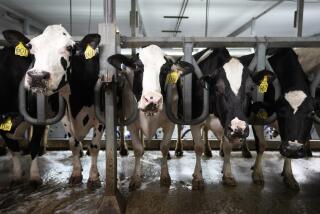Inaction Blamed in Indonesian Bird Flu Crisis
- Share via
JAKARTA, Indonesia — The avian influenza that has swept across Asia has been fueled by government error and inaction -- and nowhere is that clearer than in Indonesia.
After denying the presence of the disease for months, the Indonesian government admitted last week that bird flu had struck chickens here. On Tuesday, officials acknowledged that the deadly H5N1 strain of the virus -- which can jump to humans -- had killed millions of chickens across the country since August.
Even so, Indonesia does not appear to have come to grips with the disease.
Brushing aside the World Health Organization’s recommendation that every fowl within 3 kilometers, or a bit less than 2 miles, of an infected fowl be slaughtered, Indonesia says it plans to tackle the disease by culling chickens that are already dead.
“What we mean by ‘culling’ is that the dead chickens are not allowed to leave the farm,” said a federal Department of Agriculture spokeswoman who asked not to be named. “It’s not the living ones being buried, like we saw on TV in other countries. If we do that, the farmers will ask for compensation. For infected farms, the living ones are not going to be stamped out.”
The government’s decision to ignore the disease for months has angered farmers across the country who say that quick action could have stopped the virus before it devastated the nation’s poultry industry.
Since it first appeared in Indonesia, the disease has spread to much of the islands of Java, Bali, and parts of Sumatra and Borneo. The government estimates that the virus has killed 4.7 million chickens. The poultry industry puts the number at 16 million.
Without government action to eradicate the disease, unscrupulous farmers have been selling infected chickens and chicken meat to the public for months.
“Farmers are not going to destroy their chickens; they will sell the chickens,” said Marthen Malole, head of the Virology Laboratory at the Bogor Institute of Agriculture. “And by selling their chickens to the market, that’s how the disease is spreading from one place to another.”
Winarto, a farmer whose henhouses south of Jakarta have been hit by the virus, said infected chickens often end up as food.
“If they are big enough and ready to sell, we will sell them,” said Winarto, who like many Indonesians goes by only one name. “But if they are still small, we destroy them.”
So far, Indonesians have been lucky: Unlike in Vietnam and Thailand, health authorities here have not reported any cases of humans coming down with avian flu.
In Thailand, officials Tuesday reported the country’s fourth death from the virus, a 7-year-old boy. In Vietnam, the country that has suffered the highest human toll, there have been nine confirmed deaths.
Although the disease is deadly, the relatively low number of human cases suggests that it is not highly contagious for humans.
As in Indonesia, officials in Vietnam and Thailand initially did not disclose the outbreak among chickens. But after people started dying, the two countries slaughtered millions of chickens in accordance with the WHO guidelines.
WHO’s greatest concern is that the virus could combine with another virus in humans to cause a worldwide epidemic that could kill millions of people. Health experts believe that eliminating the flu’s “animal reservoir” is the most important step in preventing such a pandemic.
President Megawati Sukarnoputri, facing pressure from neighboring countries affected by the disease, last week acknowledged the presence of bird flu in Indonesia. But she stopped short of taking the swift action recommended by WHO, announcing instead that there would be a “selective” cull of birds stricken by the virus.
The Department of Agriculture appears to have interpreted this mandate in the narrowest way. The department spokeswoman said some farmers are voluntarily destroying diseased chickens, but the slaughter of all chickens in an infected area would be undertaken only by government order if there were an outbreak in a new location.
In regions where the disease is already established, she said, the department does not have the resources to send in teams to kill chickens or reimburse farmers for their losses. Alimuddin Sidi of the Indonesian Poultry Assn. said farmers had been advised unofficially to destroy infected chickens but not birds that appear healthy.
The World Health Organization is careful to note that it is only an advisory body and can merely recommend actions. But Georg Peterson, the agency’s representative to Indonesia, expressed disappointment that the government does not plan to kill all poultry within the recommended distance from the sources of infection.
“If you let them live, you are not stamping out the epidemic,” he said. “You are only burying the dead.
“It’s a major concern if any country is not answering properly to something that is a regional and possibly global threat,” he added.
A second part of the Indonesian government program is the vaccination of chickens.
Despite the government’s public assertions for months that chickens were dying of Newcastle disease, which is harmless to humans, many farmers knew their chickens were dying from avian flu and obtained vaccines from China to protect them. Officials say the vaccine began making a difference in December, when the number of dying chickens started to decline.
Health experts, however, say vaccination can contribute to a disease’s longevity. The vaccine keeps chickens alive, but it also may enable the virus to live longer and spread from its host to other chickens. Some experts suspect that the vaccination of birds in China in the first half of 2003 has allowed the current epidemic to become so widespread.
For months, Indonesian leaders ignored scientists and farmers whose tests showed that the chickens had avian flu.
“We have to be extra careful, because we do not want to create unnecessary loss from the impact of a hasty decision,” Agriculture Minister Bungaran Saragih said last week in explaining the government’s handling of the outbreak. “Therefore, the government could not immediately announce it to the public. That is why it seems we were slow.”
Now the country is paying a high price. Fearing infection, many Indonesians have stopped eating chicken and eggs, devastating the poultry industry. Though authorities say that eating chicken is safe if it is prepared properly, the public is skeptical.
Saragih estimates that 1.25 million Indonesians have lost their jobs due to the outbreak and that monetary losses approach $1 billion, although those figures appear high. By the official estimate, that would mean one person out of work for every four dead chickens.
It may be that the government has been reluctant to act because of elections this year.
Destroying tens of millions of chickens could prove unpopular to voters, especially since the government does not have the money to compensate farmers for their losses.
Sari Sudarsono of The Times’ Jakarta Bureau contributed to this report.
More to Read
Sign up for Essential California
The most important California stories and recommendations in your inbox every morning.
You may occasionally receive promotional content from the Los Angeles Times.










